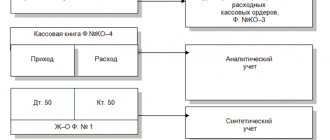When to use count 76
In accordance with the chart of accounts (order of the Ministry of Finance of Russia dated October 31, 2000 No. 94n), account 76 “Settlements with various debtors and creditors” is used to collect information related to:
- with insurance;
- claims under contracts;
- salary deposit;
- settlements based on executive documents of employees, etc.
Thus, it takes into account all settlement transactions that cannot be taken into account in other accounts.
This account is active-passive, the balance on it can be either debit or credit. In this case, the debit reflects the debt to the enterprise, and the credit reflects the debts of the enterprise itself.
For more information about accounting for receivables and payables, read the article “How are settlements with debtors and creditors reflected in accounting?” .
Find out what current debt is and how it differs from overdue debt from the Ready-made solution from ConsultantPlus. Trial access to the legal system is free.
When forming the balance, the expanded balance of account 76 is taken into account:
- Dt balances are shown on line 1230 “Accounts receivable”;
- credit balance - according to line 1520 “Accounts payable”.
Depending on the accounting policies applied by the enterprise, it is also possible to assign some groups of receivables (for example, undistributed insurance premiums) to other current assets (line 1260).
general description
Account 50 “Cash” in the chart of accounts reflects “ information” about all movements of cash held in the organization’s cash desk.
If we need to find out all the information about how much “cash” money is at our disposal, from what sources the money came and for what purposes the money was spent, then we can safely study account 50 using basic reports in the 1C program (turnover balance sheet , account analysis, account card).
Corresponding accounts by debit (Debit 50 - Credit 51, 57, 58, 60, 62, 66, 67, 69, 70, 75, 76)
Corresponding accounts for the loan (Debit 50, 51 , 57, 60 , 62, 75, 76 - Credit 50)
Property insurance
To summarize data on health insurance operations of VSK employees, as well as company assets, subaccount 76/1 “Calculations for property and personal insurance” is opened.
NOTE! Account 76/1 does not take into account contributions to the Pension Fund, Social Insurance Fund and Compulsory Medical Insurance Fund - they are accounted for using account 69.
Accounting for insurance transactions includes 3 stages:
- accrual of payments;
- enumeration;
- operations upon the occurrence of an insured event.
The accrual of payments is shown according to Kt 76/1 in interaction with cost items. So, if production equipment is insured, account 76/1 corresponds with production accounts:
Dt 20 (23, 25) Kt 76/1 - the amount of the insurance payment was allocated to production expenses.
If assets not used directly in production are insured, payments are shown as other expenses:
Dt 91/2 Kt 76/1.
The transfer of amounts presented for payment is reflected by the posting:
Dt 76/1 Kt 51 (50, 52).
In relation to tax accounting, insurance is divided into compulsory and voluntary. Expenses for compulsory insurance are taken into account in full, for voluntary insurance - in the legally established amounts (Article 255 of the Tax Code of the Russian Federation).
You can get acquainted with the features of accounting for insurance premiums in the article “Entering insurance premiums in accounting.”
How are account balances reflected in the balance sheet?
Count 76 is active-passive. This means that he can have debit and credit balances at once, and it is impossible to collapse them into one in the balance sheet.
In this regard, the balance sheet shows the size of each debt separately:
- By debit - accounts receivable to our company are entered into the balance sheet in line 1230 “Accounts receivable”;
- For a loan - our company’s accounts payable to suppliers or contractors are entered into the balance sheet in line 1520 “Accounts payable”.
Attention! In addition, the accounting policy may specify a more detailed division of balances among the subaccounts of account 76 and their reflection in the balance sheet. For example, undistributed insurance premiums can be accounted for as part of other current assets on line 1260 of the balance sheet.
Accounting for insurance compensation
If something happens to the insured property that is provided for by agreement of the parties as an insured event, the company has the right to demand compensation from the insurer.
On the date the insurance company makes a decision on payment, an entry is made (clauses 2, 7, 9, 10.2, 16 PBU 9/99):
Dt 76/1 Kt 91/1 - insurance compensation accrued.
The receipt of money into the account (cash) of companies is registered by the operation:
Dt 51 (50, 52) Kt 76/1 - the amount of compensation was credited to the current account.
Losses from insured events will be reflected in the debit of account 91.2 “Other expenses” (clauses 2, 11, 13 of PBU 10/99).
For more information about what an insurance premium is and how to calculate it, read the article “Insurance premium is...” .
Example
Gamma LLC insured the production premises against fire. According to the agreement, the company transferred 20,000 rubles to the insurance company. annually. The maximum amount of possible compensation was 400,000 rubles.
The following entries were made:
- Dt 20 Kt 76/1 - 20,000 rub. (the amount of the insurance payment has been calculated);
- Dt 76/1 Kt 51 - 20,000 rub. (insurance amount paid).
During the period of validity of the contract, a fire occurred in the insured premises. The insurer acknowledged the insured event and agreed to pay the full insurance premium.
The wiring is as follows:
Dt 76/1 Kt 91/1 - insurance compensation accrued;
Dt 51 Kt 76/1 - 400,000 rubles received. to the account as a refund.
The premises were renovated, which was carried out by a contractor and cost Gamma LLC 236,000 rubles. (including VAT RUB 39,333)
Postings:
- Dt 91/2 Kt 60 - 200,000 rub. (repair work was carried out by the contractor);
- Dt 19 Kt 60 - 39,333 rub. (VAT included);
- Dt 60 Kt 51 - 239,333 rub. (paid for work).
In addition, construction materials worth RUB 120,000 were purchased for the work. (including VAT RUB 20,000):
- Dt 10 Kt 60 - 100,000 rub. (building materials were purchased);
- Dt 19 Kt 60 - 20,000 rub. (VAT highlighted);
- Dt 60 Kt 51 - 120,000 rub. (money was transferred for building materials);
- Dt 91/2 Kt 10 - 100,000 rub. (purchased building materials were released into production).
As for VAT, if property is repaired, this tax can be reimbursed from the budget in the usual manner (letter of the Ministry of Finance of the Russian Federation dated June 17, 2015 No. GD-4-3 / [email protected] ). This operation will correspond to the wiring Dt 68 Kt 19.
Employee insurance
Accounting for information related to life and health insurance of employees is similar to accounting for property insurance transactions. The difference is that when an employee pays the amount transferred to the company by the insurer as an insurance premium (if there was an insured event), account 76/1 interacts with account 73. Accounting account 73 is settlements with personnel for other transactions:
- Dt 76/1 Kt 73 - reflects the accrued amount of insurance compensation to be paid to the injured employee;
- Dt 51 Kt 76/1 - insurance compensation received, payable to the insured employee;
- Dt 73 Kt 50 (51) - the employee was paid the insurance amount.
Accounting for claims
To reflect information about claims against counterparties against account 76, a subaccount 76/2 “Claims” is opened. It is used in cases where the counterparty has violated any obligations, there are comments on the quality and quantity of the goods supplied, deadlines have not been met, errors have been found in documents, etc.
How to properly submit a claim, read the material “The procedure for filing a claim and the rules governing it.”
For a sample of writing a complaint, look in the materials:
- “How to write a claim for poor quality service - sample”;
- “Claim for payment of debt under a supply agreement”;
- “Sample claim under a lease agreement for non-residential premises.”
For example, if a shortfall is detected (before the values are accepted for accounting), the accountant makes the following entries:
Dt 76/2 Kt 60 - the amount of the claim is reflected.
If a shortfall is detected after acceptance, the claims account is debited with the accounts of inventories, goods and other valuables that are the subject of the transaction:
Dt 76/2 Kt 10 (41).
The agreement with the counterparty may provide for penalties (fines, penalties, penalties). Then the score is applied with a score of 91/1:
Dt 76/2 Kt 91/1 - the amount of the penalty is attributed to other income.
See also “Sample Claim for Penalty”.
The receipt of claims amounts is reflected by the following entries:
Dt 51 (50, 52) Kt 76/2 - money has been credited to the account.
If the demand is made by the organization itself, such calculations are also reflected in account 76/2. Accounting is carried out in a similar way, only in this case the company is no longer a debtor, but a creditor, and the amounts of claims recognized by it in relation to other parties to the transaction are credited to the accounts of the subject of the claim: Dt 10 (41) Kt 76/2.
For possible objections to a claim, see the article “Sample response to a claim under a work contract.”
Description of the account “Settlements with other suppliers and contractors”
Subaccount 76.05 “Settlements with other suppliers and contractors” was created for mutual settlements with counterparties, transactions with which do not relate to the main activities of the organization.
As a rule, the account reflects accruals for various duties, fees, and environmental calculations. The account is used to make calculations for fees for performing notarial acts (when buying or selling an organization’s property), as well as for various court fees associated with the consideration of a court case.
Analytical accounting for subaccount 76.05 is organized for each supplier separately.
What to do if it is impossible to collect a claim
In certain cases, it is impossible to obtain amounts of penalties and fines. Such situations include:
- lapse of time;
- the court's decision;
- liquidation of the debtor;
- reaching agreement through negotiations.
The amounts of claims are written off from account 76 to the account of the reserve for doubtful debts or to financial results (clause 77 of the Accounting Regulations, approved by order of the Ministry of Finance of the Russian Federation dated July 29, 1998 No. 34n).
The procedure for writing off unrealistic debt is described in detail in the Ready-made solution from ConsultantPlus:
If you do not already have access to this legal system, a full access trial is available for free.
Example 2
Gamma LLC entered into a purchase and sale agreement for materials with Delta LLC for a total amount of 100,000 rubles. Delta LLC is not a VAT payer.
In accordance with the terms of the agreement, Gamma LLC transferred a 50% advance to:
Dt 60 Kt 51 - 50,000 rub. (advance paid).
After the materials were delivered to the buyer, it turned out that the goods were worth 10,000 rubles. defective. The seller received a claim for this amount:
Dt 76/2 Kt 60 - 10,000 rub. (a claim has been made).
The management of Delta LLC got acquainted with the buyer’s requirements and decided to satisfy them, but not in full, but only for the amount of 8,000 rubles, since the goods were worth 2,000 rubles. was not defective, the buyer’s comments to it were unfounded:
- Dt 51 Kt 76/2 — 8,000 rub. (received based on the submitted claim);
- Dt 60 Kt 76/2 — 2,000 rub. (a claim not satisfied by the seller has been written off).
The procedure for writing off receivables and payables on account 60
According to accounting requirements, only true facts must be reflected in accounting data and reporting. If the documents show accounts payable with an expired collection period, then this rule is violated.
Thus, the company is obliged to write off accounts payable if the collection period established by law has passed.
In addition, a debt that can no longer be repaid is subject to removal if the counterparty has been deregistered and no longer exists as a legal entity.
The law establishes that the period during which the creditor has the right to demand its coverage is set at 3 years. In this case, it is necessary to correctly determine the beginning of this period.
When concluding a supply or service agreement, this document usually indicates the date for repayment of obligations. From the day following it, you need to start counting the statute of limitations.
However, the law provides for the deadline to be reset and counted from the beginning. This happens if the debtor acknowledges the existing debt in writing, makes partial payment, signs a reconciliation report, etc. In this situation, the limitation period must be counted first from this moment.
Attention! However, this cannot be done indefinitely. When a period of 10 years has been reached from the date of its formation, the debt must be written off unconditionally.
The debt write-off process is carried out in the following order:
- Carrying out an inventory of all payments. This procedure must be performed annually in order to compare the accounting data with the actual amounts of debt. During the inventory, it is also checked on what date the last movement on this debt occurred.
- Registration of an inventory report. There is a recommended form of the INV-17 form, but currently the company has the right to use its own forms. It is necessary to include in the act all the debts the company has, and not just the identified overdue ones. The document is drawn up in two copies, one is transferred to the accounting department, and the second remains with the commission.
- Preparation of accounting certificates. The accountant must analyze the executed act and draw up a certificate based on it. It reflects the counterparty for which there is a debt, the reason for the occurrence, the amount of the debt, as well as the day when the statute of limitations expired. Certificates of all expired debts, together with the act, are transferred to the manager for consideration and decision-making.
- Making an order. If the manager decides to write off, then he gives instructions to draw up an order to write off the debt. This document provides instructions to write off debt in accounting and tax accounting, and also appoints responsible persons. Based on the order, the accountant prepares accounting entries.
Accounting for dividends
If an organization owns shares or interests in other companies, it is entitled to receive dividends. To reflect such transactions, a subaccount 76/3 “Dividends” is opened.
Accrued amounts are shown on the invoice CT, received - on Dt:
- Dt 76/3 Kt 91/1 - dividends due are charged to other income;
- Dt 51 (50, 52) Kt 76/3 - the organization received dividend amounts.
For more information about accounting for dividends from recipients and payers, read the article “Accounting entries when paying dividends.”
You can learn more about the nuances of paying dividends in the article “The procedure for paying dividends to founders in an LLC in 2021.”
The article “How to correctly calculate the tax on dividends?” will tell you about the taxation of dividends.
Salary deposit
Deposited amounts are funds that are the employee’s reserved wages, which for some reason he was unable to receive on time. Such money is accounted for in subaccount 76/4 “Deposited amounts”.
According to Kt they show the accrual of amounts in correspondence with account 70: Dt 70 Kt 76/4 - the salary amount is deposited.
Payments of deposited amounts are shown by the entries: Dt 76/4 Kt 50 (51) - deposited salary paid.
If for some reason a company employee never came for the money, and the statute of limitations for such payments has expired, the money is received as other income of the organization: Dt 76/4 Kt 91/1 - the amount of unclaimed deposited salary is included in other income.
Commission agreements
Calculations under commission agreements are also carried out in accounting using account 76. In this case, analytical accounting is carried out for each agreement separately. The principal, the seller of goods, makes the following entries:
- Dt 45 Kt 41 - goods transferred to the commission agent;
- Dt 76 Kt 68 - allocated VAT on the advance received by the commission agent from the buyer;
- Dt 76 Kt 90 - revenue received by the commission agent;
- Dt 90 Kt 45 - sold goods are written off;
- Dt 90 Kt 68 - VAT is charged on the amount of revenue;
- Dt 68 Kt 76 - VAT on advance to be deducted;
- Dt 44 Kt 76 - the intermediary's commission is included in sales expenses;
- Dt 19 Kt 76 - VAT is allocated from the commission amount;
- Dt 68 Kt 19 - VAT on commission to be deducted;
- Dt 51 Kt 76 - money received from the commission agent.
NOTE! Revenue under such contracts is recognized in full, that is, it is not reduced by commission and additional fees. intermediary income.
For information on how to correctly account for VAT and prepare documents during intermediary transactions, read the article “How to prepare invoices when selling goods through an intermediary?” .
When concluding agency agreements, accounting is also maintained using account 76. You can read more in the article “Features of an agency agreement in accounting.”
Examples of accounting entries for account 76
The following transactions can be made with this account:
| Debit | Credit | Name |
| 76 | 20, 23, 29 | Write-off of part of the costs of main, auxiliary or servicing production to other debtors or creditors |
| 76 | 21 | Sales of our own semi-finished products |
| 76 | 28 | Write-off of losses from marriage |
| 76 | 41 | Returning defective goods to the supplier |
| 76 | 43 | Reflection of the debt of other debtors for shipped commercial products |
| 76 | 50 | Payment of accounts payable in cash from the cash register |
| 76 | 50 | Return of funds from the cash register to the buyer (other creditor) |
| 76 | 51, 52, 55 | Payment of accounts payable with money from a current account, foreign currency account or from special accounts |
| 76 | 60 | Accounts payable for other transactions are reflected |
| 76 | 68/VAT | Reflection of VAT debt |
| 76 | Unpaid wages have been deposited | |
| 76 | 86 | Targeted funding received from the budget |
| 76 | 86 | Membership (entrance) fees have been charged to the partnership |
| 76 | 91 | Interest accrued on bonds |
| 76 | 08 | Writing off work that did not bring the desired result |
| 76 | 91/1 | Reflection of income from other sales |
| 76 | 91/2 | Write-off of receivables that are not collectible |
| 04 | 76 | The company's positive business reputation is reflected |
| 08 | 76 | Reflection of costs for exclusive copyright of a computer program |
| 76 | Materials purchased from another supplier | |
| 15 | 76 | Reflection of costs for procurement of materials |
| 19 | 76 | Reflection of input VAT on work (services) of another creditor |
| 20 | 76 | Inclusion of costs for other operations in production costs |
| 23 | 76 | Inclusion of costs for other operations as part of costs for auxiliary production |
| 41 | 76 | Receipt of goods from other creditor |
| 44 | 76 | Inclusion of costs for other operations as part of sales expenses |
| 50 | 76 | Received payment from other debtor in cash to the cash desk |
| 51, 52, 55 | 76 | Payment received from another debtor to a current account, foreign currency account or special account |
| 57 | 76 | Reflection of a transfer that has not yet been received from another debtor |
| 58 | 76 | The purchase of shares and securities is reflected |
| 76 | Settlement of debt | |
| 91/2 | 76 | Reflection of other expenses |
| 97 | 76 | Reflection of deferred expenses |
You might be interested in:
Account 19 in accounting: what is it used for, subaccounts, characteristics, postings
Leasing agreements
The procedure for accounting for transactions under leasing agreements depends on where the subject of the financial lease is listed: on the balance sheet of the recipient company or the lessor.
From January 1, 2022, rental (leasing) transactions are accounted for in accordance with FAS 25/2018 “Lease Accounting”. You can start applying the Standard earlier. A ready-made solution from ConsultantPlus will help you switch to the new rules for leasing accounting. Trial access to the system can be obtained for free.
If the object is on the balance sheet of the lessor, the lessee organization shows such property as leased on off-balance sheet accounts. Records are generated:
- Dt 76 Kt 51 - advance payment paid;
- Dt 001 - the object is accepted for accounting;
- Dt 20 (26, 44) Kt 76 - lease payment due;
- Dt 19 Kt 76 - VAT on payment;
- Dt 68 Kt 19 - VAT deductible;
- Kt 001 - the subject of a financial lease is written off at the end of the contract.
Read more about accounting entries for the lessor and lessee in the material “Leasing under the simplified tax system, income minus expenses - entries.”
If, in accordance with the agreement, the property is placed on the balance sheet of the lessee, the organization accounts for the subject of the financial lease as fixed assets. In this case, the initial cost will be the sum of all transfers reflected in the contract, including advance payments, regular current payments, as well as the redemption fee, if provided.







